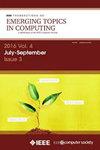HARPOCRATES: An Approach Towards Efficient Encryption of Data-at-Rest
IF 5.4
2区 计算机科学
Q1 COMPUTER SCIENCE, INFORMATION SYSTEMS
IEEE Transactions on Emerging Topics in Computing
Pub Date : 2024-04-17
DOI:10.1109/TETC.2024.3387558
引用次数: 0
Abstract
This paper proposes a new block cipher called HARPOCRATES, which is different from traditional SPN, Feistel, or ARX designs. The new design structure that we use is called the substitution convolution network. The novelty of the approach lies in that the substitution function does not use fixed S-boxes. Instead, it uses a key-driven lookup table storing a permutation of all 8-bit values. If the lookup table is sufficiently randomly shuffled, the round sub-operations achieve good confusion and diffusion to the cipher. While designing the cipher, the security, cost, and performances are balanced, keeping the requirements of encryption of data-at-rest in mind. The round sub-operations are massively parallelizable and designed such that a single active bit may make the entire state (anHARPOCRATES:高效加密静态数据的方法
本文提出了一种新的分组密码HARPOCRATES,它不同于传统的SPN、Feistel或ARX设计。我们使用的新设计结构被称为替换卷积网络。该方法的新颖之处在于代换函数不使用固定的s盒。相反,它使用一个键驱动的查找表来存储所有8位值的排列。如果查找表足够随机地洗牌,则轮子操作可以很好地混淆和扩散到密码中。在设计密码时,要平衡安全性、成本和性能,同时考虑到静态数据的加密需求。轮子操作是大规模并行的,并且设计成单个活动位可以使整个状态(一个$8 \乘以16$二进制矩阵)在一轮中活动。我们分析了该密码在线性、微分和不可能微分密码分析下的安全性。该密码对许多其他攻击的抵抗力,如代数攻击,结构攻击和弱密钥也显示。我们从软件和硬件两方面实现了密码;发现该密码的软件实现比许多已知的密码具有更好的吞吐量。虽然HARPOCRATES适合于静态数据的加密,但它也非常适合于传输中的数据环境。
本文章由计算机程序翻译,如有差异,请以英文原文为准。
求助全文
约1分钟内获得全文
求助全文
来源期刊

IEEE Transactions on Emerging Topics in Computing
Computer Science-Computer Science (miscellaneous)
CiteScore
12.10
自引率
5.10%
发文量
113
期刊介绍:
IEEE Transactions on Emerging Topics in Computing publishes papers on emerging aspects of computer science, computing technology, and computing applications not currently covered by other IEEE Computer Society Transactions. Some examples of emerging topics in computing include: IT for Green, Synthetic and organic computing structures and systems, Advanced analytics, Social/occupational computing, Location-based/client computer systems, Morphic computer design, Electronic game systems, & Health-care IT.
 求助内容:
求助内容: 应助结果提醒方式:
应助结果提醒方式:


